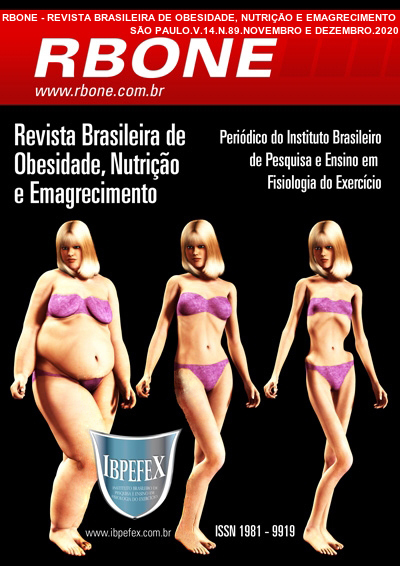Where's the rice and beans that ‘were’ here? Industrialized foods consumed by Brazilian families
Abstract
Eating practices are important determinants in the health conditions of people in all age groups. Therefore, the objective is to identify characteristics of food consumption by Brazilian families. To achieve the proposed objective, the Family Budget Survey (POF) carried out in the years 2002/2003 and 2008/2009 will be used. Data on the following groups were analyzed: cereals and legumes and prepared foods and industrial mixtures, in which variations by region were assessed. In view of this, the changes observed in the dietary pattern of the Brazilian population, detected during the two surveys, proved to be similar and include: 1) significant reduction in the consumption of cereals and legumes in all states and 2) increased consumption of prepared foods and industrial mixtures. The biggest changes observed in relation to the reduction in the consumption of cereals and legumes, were in the Southeast region (48.13 Kg / year per capita to 35.65 Kg / year) then, the Northeast (52.35 Kg to 43.58 Kg). Regarding the consumption of prepared foods and industrial mixtures, the greatest increase was observed in the Midwest region (1.73 kg to 3.18 kg) followed by the north (1.87 kg to 3.11 kg). These results are in line with the study by Pereira (2014), in which there is a percentage reduction in expenses with rice and beans, foods that have always been present at the table of all social classes and in the studies carried out by Bezerra et al., (2013), where according to the author there is a relevant increase in the participation of ready-to-eat industrialized foods in the Brazilian diet, which are probably consumed in substitution for more traditional items, such as rice and beans. Therefore, the eating habits of the Brazilian population are changing.
References
-ABIA. Associação Brasileira das Indústrias da Alimentação. Consumo de alimentos em novo patamar. ABIA Informa. 272. São Paulo. 1997.
-Aquino, R. C.; Philippi, S.T. Consumo infantil de alimentos industrializados e renda familiar na cidade de São Paulo. Revista de Saúde Pública. Vol. 36. p. 655-660. 2002.
-Belik, W.; Siliprandi, E. Hábitos Alimentares, Segurança e Soberania Alimentar. In Vilarta, R.; Gustavo, L.; Gutierrez, G.l.; Monterio, M.I. (Orgs.). Qualidade de Vida: Evolução dos Conceitos e Práticas no Século XXI. Vol. 1. p.187-196. 2010.
-Bezerra, I. N.; Souza, A. D. M.; Pereira, R. A.; Sichieri, R. Consumo de alimentos fora do domicílio no Brasil. Revista Saúde Pública. Vol. 47. supl.1. p. 200S-211S. 2013.
-Bielemann, R. M.; Motta, J. V. S.; Minten, G. C.; Horta, B. L.; Gigante, D. P. Consumo de alimentos ultra processados e impacto na dieta de adultos jovens. Revista de Saúde Pública. Vol. 49. 2015.
-Bleil, S. I. O padrão alimentar ocidental: considerações sobre a mudança de hábitos no Brasil. Cadernos de Debate. Vol. 6. Núm. 1. p. 1-25. 1998.
-Garcia, R. W. D. Representações sociais da comida no meio urbano: um estudo no centro da cidade de São Paulo. Dissertação de Mestrado em Psicologia Social. IPS/USP. São Paulo. 1993.
-IBGE. Instituto Brasileiro de Geografia e Estatística. Coordenação de Trabalho e Rendimento. Pesquisa de Orçamentos Familiares - POF 2008-2009: aquisição alimentar domiciliar per capita. Rio de Janeiro. IBGE. 2011.
-IBGE. Instituto Brasileiro de Geografia e Estatística-IBGE. POF 2008-2009-Conceitos e métodos. Disponível em: https://metadados.ibge.gov.br/consulta/estatisticos/operacoes-estatisticas/OF. Acessado em: 03/07/2018.
-IBGE. Instituto Brasileiro de Geografia e Estatística. POF. 2002. Disponível em: https://ww2.ibge.gov.br/home/estatistica/populacao/condicaodevida/pof/2002analise/default_.shtm. Acessado em: 22/05/2018.
-Instituto de Pesquisa AC Nielsen. Tendências 97. São Paulo. 1997.
-Louzada, M. L. C.; e colaboradores. Alimentos ultra processados e perfil nutricional da dieta no Brasil. Revista de Saúde Pública. Vol. 49. 2015.
-Maluf, R. S. J. Segurança alimentar e nutricional. 2ª edição. Rio de Janeiro. Vozes. 2009.
-Marinho, M. C. S.; Hamann, E. M.; Lima, A. C. C. F. Práticas e mudanças no comportamento alimentar na população de Brasília, Distrito Federal, Brasil. Revista Brasileira de Saúde Materno Infantil. Vol. 7. Núm. 3. p. 251-261. 2007.
-Mondini, L.; Monteiro, C. A. Mudanças no padrão de alimentação. In: Velhos e novos males da saúde no Brasil: a evolução do país e de suas doenças. p. 79-89.1995.
-Oliveira, S. P.; Thébaud-Mony, A. Estudo do consumo alimentar: em busca de uma abordagem multidisciplinar. Revista de Saúde Pública. Vol. 31. p. 201-208. 1997.
-Pereira, S. M. R. S. Antropologia da alimentação: cultura e unidade de alimentação e nutrição. In: Baichiunas, D. Gestão de UAN: um resgate do binômio alimentação e nutrição. São Paulo. Roca 2014. 304p.
Copyright (c) 2022 Thayrine Silva Reis

This work is licensed under a Creative Commons Attribution-NonCommercial 4.0 International License.
Authors who publish in this journal agree to the following terms:
- Authors retain the copyright and grant the journal the right of first publication, with work simultaneously licensed under the Creative Commons Attribution License BY-NC which allows the sharing of the work with acknowledgment of the authorship of the work and initial publication in this journal.
- Authors are authorized to enter into additional contracts separately for non-exclusive distribution of the version of the work published in this journal (eg, publishing in institutional repository or book chapter), with acknowledgment of authorship and initial publication in this journal.
- Authors are allowed and encouraged to post and distribute their work online (eg, in institutional repositories or on their personal page) at any point before or during the editorial process, as this can bring about productive change as well as increase impact and impact. citation of published work (See The Effect of Free Access).






